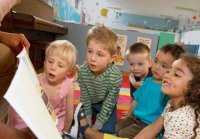First Day of Kindergarten: 8 Survival Skills
The first day of kindergarten is busy, busy, busy! Learning the names, faces, parents and personalities of all of the students on the class list is essential. You must teach routines and procedures. You need to hold the attention of a roomful of active, excited little minds. New faces will show up that you'll have to add to the class list.
Be prepared for kinks in the plans. Bus numbers will change. Duty assignments will be modified -- now you have morning and afternoon duties for the first few weeks. Lesson plans are due -- and the principal wants lessons plans for the entire week. And no, there is no nap time for the students (or the teacher)! Oh, and don't forget open house -- teachers will need to stay into the evening (I hate it when people think teachers get off at 3:00 every afternoon), but still be at work on time the following morning to receive students.
What does a kindergarten teacher need to do to survive? Here are eight handy survival skills.
1. Nametags
Some kindergarteners may be new to the "school experience." Moving to the cafeteria, going to the bathroom, and working in their classroom may be brand new concepts to them. Have students wear nametags with their name, their school, and their teacher's name for the first week or two. Not only will this help teachers and other support staff learn their names, but it will also help ensure their safety during transition and dismissal time. (And have spare nametags -- a couple of students will mysteriously lose theirs.)
2. Lunch Plan
If your school provides kindergarteners with lunch, know how each student will eat lunch. Find out how much students need for lunch. Have this information ahead of time so that you can answer parents' questions. Make sure you have a procedure in place to collect money and pay for lunches.
3. Going Home
Make it your business to know how each student will get home from school. Find out if he or she is riding the bus or being picked up. Make sure the students are being released to the proper guardian or caretaker. Know this information ahead of time and communicate with each parent to find out if there are any changes. Write down each student’s method of transportation on his or her nametag to help ensure smooth dismissal -- for example, "bus # 100" or "car rider."
4. Transition Times
Twenty kindergarteners will not sit still at their desks or stand perfectly in line the first day -- or any day -- if it's for a long period of time with no structured activity. Minimize transition times as much as possible. For example, once students have put up their pencils, they may continue to independently work on their coloring activity while the other students put up their pencils.
5. Lines
Keep the lunch line moving (money is out and ready), or keep the water fountain line moving (each student has ten seconds to drink water then back to line). Stop the line every so often to check that it remains straight and students are quiet. If a student loses a shoe (someone always will), have that student step out of line to fix the shoe while the line continues. When the line comes to a stop, the student may walk back to his or her place or remain at the end.
6. Keep Students Busy
Whole group instruction may include calendar or story time. Small group activities should be structured. For example:
- Show the kids how to build patterns with blocks, and give visible examples so they'll know what is expected.
- Show them how to match lowercase and uppercase letters. For the first few weeks, set up a model showing what the lower- and uppercase letters look like.
7. Behavior
Show interest in all of your students. Make each one feel wanted. Do not assume they know how to do anything. Give clear directions, and have students demonstrate back the expected behavior to ensure understanding.
8. Be Prepared
Elementary teachers are expected to have pencils, papers, colors, construction paper and glue, but kindergarten teachers should be even more prepared with:
- A spare change of clothing in case a student forgot his or hers and has an accident
- Some non-latex bandages in case students have latex allergies
- A belt in case a student shows up without properly fitting pants
- A large bottle of water stashed for yourself, because you will break a sweat at some point and get very thirsty
- A squishy ball, which sometimes helps a student who is extremely fidgety
Kindergarten teachers have one of the most challenging but rewarding jobs. When something goes wrong, just breathe and stay calm. When the day is over, think of a plan to better handle the situation next time. The first days are very challenging, but stand firm, stay committed and have a great year.
